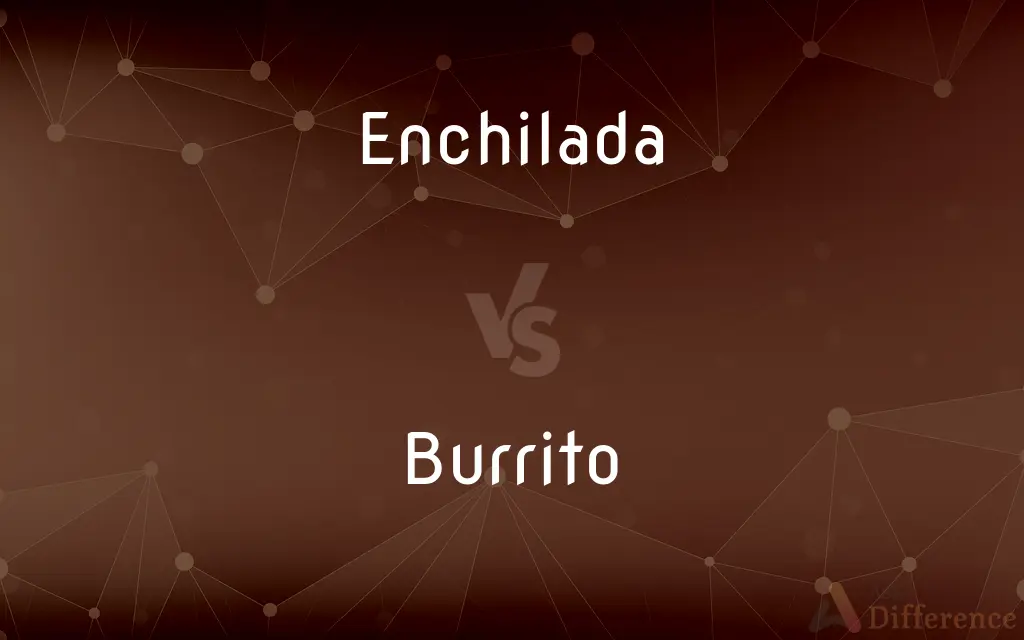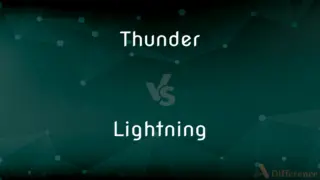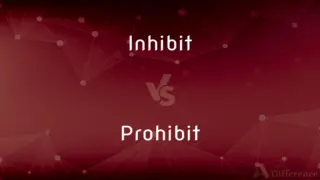Enchilada vs. Burrito — What's the Difference?
Edited by Tayyaba Rehman — By Urooj Arif — Updated on March 7, 2024
Enchiladas are corn tortillas filled with ingredients like meat and cheese, covered in chili sauce, then baked. Burritos are flour tortillas wrapped around a filling, often including beans, meat, and rice, served without sauce on top.

Difference Between Enchilada and Burrito
Table of Contents
ADVERTISEMENT
Key Differences
Enchiladas originate from Mexican cuisine and are known for their rich, chili sauce-covered exterior. They are typically made with corn tortillas, which are filled with a variety of ingredients such as chicken, beef, cheese, or beans, then rolled and covered with a chili sauce before being baked in the oven. This preparation method gives enchiladas their distinctive moist texture and spicy flavor. Whereas burritos, also of Mexican origin but popularized in Tex-Mex cuisine, consist of large flour tortillas that enclose a hearty filling, which can include beans, meat, cheese, rice, and vegetables. The key characteristic of burritos is that they are wrapped and eaten with hands, often without sauce on the exterior, making them less messy and more portable.
The sauce is a defining feature of enchiladas, with the choice of chili sauce playing a critical role in the dish's flavor profile. Enchiladas are served in a baked form, allowing the sauce to infuse into the tortilla and filling, creating a cohesive dish. On the other hand, burritos may come with sauce or salsa, but it is typically served on the side or lightly included within the filling, not as a central component of the dish.
Size and portability differ significantly between the two. Burritos, with their larger flour tortillas, can hold more ingredients and are designed to be a self-contained meal that can be easily held and eaten without utensils. Enchiladas, being smaller and covered in sauce, are usually eaten with a fork and knife and considered less portable.
The choice between corn and flour tortillas also impacts the texture and taste of each dish. Corn tortillas, used in enchiladas, offer a firmer texture and a more pronounced corn flavor, which complements the chili sauce. Flour tortillas, used in burritos, are softer and more neutral in flavor, making them a versatile wrapper for a wide range of fillings.
Both enchiladas and burritos offer a delicious insight into Mexican and Tex-Mex cuisines, with each providing unique flavors and eating experiences. Whether one prefers the saucy, baked goodness of enchiladas or the hearty, wrap-and-go convenience of burritos often comes down to personal taste and occasion.
ADVERTISEMENT
Comparison Chart
Tortilla Type
Corn
Flour
Sauce
Covered in chili sauce, baked
Sauce served on the side, if at all
Eating Method
Typically with utensils
Handheld
Origin
Mexican
Mexican/Tex-Mex
Fillings
Meat, cheese, beans
Beans, meat, cheese, rice, vegetables
Compare with Definitions
Enchilada
Corn tortilla base.
The enchilada was made with a soft corn tortilla, rolled and baked.
Burrito
Flour tortilla wrapper.
The burrito's large flour tortilla wrapped around a generous filling.
Enchilada
Chili sauce covering.
Covered in a spicy chili sauce, the enchilada was flavorful and moist.
Burrito
Handheld convenience.
Wrapped tightly, the burrito was perfect for on-the-go eating.
Enchilada
Served with utensils.
Due to the sauce, enchiladas are typically eaten with a fork and knife.
Burrito
Sauce on the side.
The burrito was served with salsa on the side for dipping.
Enchilada
Variety of fillings.
Chicken and cheese enchiladas are a popular choice at Mexican restaurants.
Burrito
No baking required.
Unlike enchiladas, burritos are assembled and served without the need for baking.
Enchilada
Baked dish.
Baking the enchilada allowed the flavors to meld beautifully.
Burrito
Hearty fillings.
The burrito was packed with rice, beans, and grilled steak.
Enchilada
An enchilada (, Spanish: [entʃiˈlaða]) is a corn tortilla rolled around a filling and covered with a savory sauce. Originally from Mexican cuisine, enchiladas can be filled with various ingredients, including meats, cheese, beans, potatoes, vegetables, or combinations.
Burrito
A burrito (English: , Spanish: [buˈrito] (listen)) is a dish in Mexican and Tex-Mex cuisine that took form in California cuisine, consisting of a flour tortilla wrapped into a sealed cylindrical shape around various ingredients. The tortilla is sometimes lightly grilled or steamed to soften it, make it more pliable, and allow it to adhere to itself when wrapped.
Enchilada
A tortilla rolled and stuffed usually with a mixture containing meat or cheese and served with a sauce spiced with chili.
Burrito
A flour tortilla wrapped around a filling, as of beef, beans, or cheese.
Enchilada
A Mexican dish made by wrapping a filling in a tortilla, then baking in a sauce.
Burrito
A Mexican dish consisting of a flour tortilla wrapped around a filling of meat and/or beans, cheese etc.
Enchilada
Tortilla with meat filling baked in chili-seasoned tomato sauce
Burrito
(slang) To wrap someone or something up like a burrito.
Burrito
A flour tortilla folded around a filling.
Burrito
A flour tortilla folded around a filling
Common Curiosities
Can enchiladas be made with flour tortillas?
Traditionally, enchiladas are made with corn tortillas, but flour tortillas can be used, though this might alter the classic taste and texture.
Are burritos traditionally served in Mexico?
While burritos have roots in Mexican cuisine, the version many are familiar with today—large, flour-tortilla-wrapped with numerous fillings—is more a product of Tex-Mex cuisine.
Is there a difference between Tex-Mex and traditional Mexican burritos?
Yes, traditional Mexican burritos are typically smaller and contain fewer, simpler ingredients, while Tex-Mex burritos are larger and filled with a variety of ingredients.
Can enchiladas be vegetarian?
Yes, enchiladas can easily be made vegetarian by using fillings like beans, cheese, and vegetables.
Why are burritos considered more portable than enchiladas?
Burritos are wrapped and can be eaten with your hands, making them convenient for eating on the go, unlike enchiladas, which are typically covered in sauce and require utensils.
Can you freeze enchiladas and burritos?
Yes, both enchiladas and burritos can be frozen. Enchiladas should be baked first, while burritos can be wrapped tightly and frozen individually for easy reheating.
What types of chili sauce are used for enchiladas?
Enchiladas can be covered with various chili sauces, including red, green, or mole, depending on the recipe and regional preference.
How do you keep enchiladas from becoming soggy?
To prevent sogginess, avoid over-soaking the tortillas in sauce before baking and ensure the oven is properly preheated to bake the enchiladas efficiently.
What's a common side dish for enchiladas and burritos?
Both enchiladas and burritos can be served with sides like rice, beans, guacamole, and salsa to complement the main dish.
What makes an enchilada an enchilada?
The combination of a corn tortilla, a filling, a chili sauce covering, and being baked together defines an enchilada.
Share Your Discovery

Previous Comparison
Thunder vs. Lightning
Next Comparison
Inhibit vs. ProhibitAuthor Spotlight
Written by
Urooj ArifUrooj is a skilled content writer at Ask Difference, known for her exceptional ability to simplify complex topics into engaging and informative content. With a passion for research and a flair for clear, concise writing, she consistently delivers articles that resonate with our diverse audience.
Edited by
Tayyaba RehmanTayyaba Rehman is a distinguished writer, currently serving as a primary contributor to askdifference.com. As a researcher in semantics and etymology, Tayyaba's passion for the complexity of languages and their distinctions has found a perfect home on the platform. Tayyaba delves into the intricacies of language, distinguishing between commonly confused words and phrases, thereby providing clarity for readers worldwide.













































